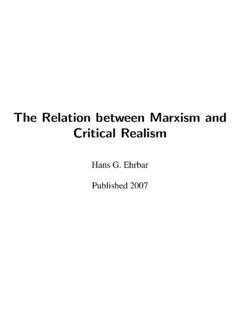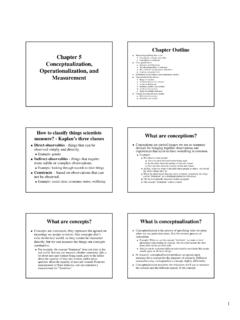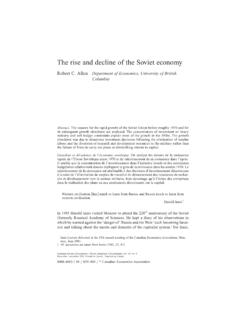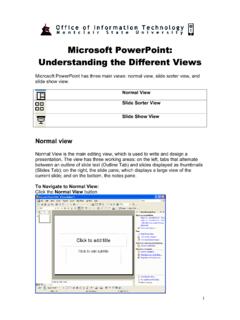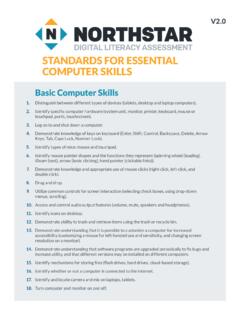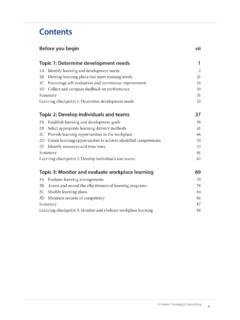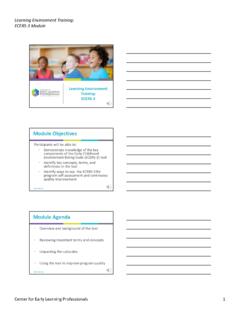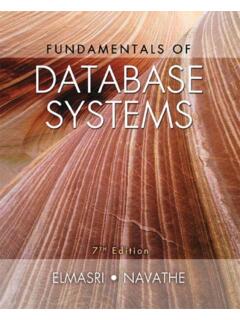Transcription of Looking for reality Chapter 1 Human Inquiry and Science
1 Chapter Outline Looking for reality Ordinary Human Inquiry Chapter 1 .. Tradition Authority Human Inquiry and .. Errors in Inquiry and some solutions What's really real? The foundations of social Science Science .. Theory, not philosophy or belief Social regulations Aggregates, not individuals A variable language Some dialectics of social research Ideographic and nomothetic explanation Inductive and deductive theory Quantitative and qualitative data Pure and applied research Why do we need to know? How do we know what we know? Inquiry is a natural Human activity. Much of Direct Experience and Observation (experiential reality ). ordinary Human Inquiry seeks to explain events Example: You touch the stove when it's burning to see if it really really is hot.
2 And predict future events. Agreed- Agreed-On Knowledge (agreement reality ): we consider things to be true because we are told that they are true. Two types of agreement reality Tradition: the things that everybody knows . These can be very culturally related. Example: The earth is round. Authority: derives from the status of the transmitter of the knowledge teachers, parents, etc. Example: Things learned in a class. How do we know what we know is Do we make mistakes in the process? - real /true? Looking for reality Errors in personal Inquiry We use two criteria to judge Inaccurate observations Think about the last person you talked to before reading this: what what kind Logical support (theory) A scientific of shoes was she/he wearing?
3 Most of us cannot remember accurately accurately because we were not paying special attention to that. understanding of the world must make logical How to prevent? - By mandating conscious observation sense Overgeneralization assume that a few similar events are Empirical support (observation) A scientific evidence of a general pattern Suppose you read two newspaper stories on lazy welfare mothers, you understanding must not contradict actual therefore conclude that all welfare mothers are lazy. observation One or two cases are not enough to lead so such general conclusions. conclusions. How to prevent this? - By employing large random samples (you should study many welfare mothers to see if there is a general pattern). pattern).
4 And by replicating studies (this should be studied in different cities, at different times, with different samples, and by different researchers). researchers). 1. Do we make mistakes in the Process? - But what is reality /truth? Three Errors in personal Inquiry views of reality Selective observation- observation- paying attention to events that match a Premodern prior conclusion and ignore those that do not. Things are as they seem to be. In the welfare mother example: when you have formed your opinion I think John is very handsome, and that has to be the truth. If other that welfare mothers are lazy, you will then pay special attention attention to people see him as not, then they are wrong. other stories on lazy welfare mothers.
5 Modern How to prevent? - By specifying in advance the number and types of Acknowledgment of Human subjectivity. observations to be made and by having several scientists investigate investigate the I think John is very handsome. You think he is so so. And Larry may same phenomenon. think John is ugly. The three of us have different ideas (realities), (realities), and I. can accept that. But there is still the notion that whether somebody somebody is Illogical reasoning handsome or not can be judged. We just judge them differently. An extended period of good weather may lead you to worry that it is Postmodern certain to rain on the weekend outdoor event you have planned. There is no objective reality to be observed. How to prevent?
6 - By using systems of logic consciously and explicitly. There is no such thing as whether somebody is handsome or not. It's It's all a matter of subjectivity. Does social Science research answer What are the three aspects of the what should be? scientific enterprise? Social Science research attempts to answer Social Science = theory + data collection + data analysis what is, not what should be. Theory - deals with logic. This links back to the logic aspect of judging what is real and what is Social Science is about fact finding, about finding not. It deals with what is, not what should be. It is not a belief belief or regularities in social life. philosophy. Theories should not be confused with philosophy Data collection - deals with observation.
7 This links back to the observational aspect of judging what is real real and or belief. what is not. Data analysis - deals with the comparison of what is logically expected with what is actually observed. What do we try to find out? - Social At what level do social regulations hold? At regularities the aggregate level, not individual level In large part, social scientific theory aims to find Aggregates mean the collective actions and situations of many patterns in social life. individuals. Examples: Example: Social Science researchers are interested in the general general Only people aged 18 and above can vote. reasons why people divorce, but not particularly interested in why why Mr. Only people with a license can drive. and Mrs.
8 Smith decided to get a divorce. We still study Mr. and Mrs. Smith, but only as one observation among many. Men earn more than women. The focus of social Science is to explain why aggregated How do we deal with exceptions? patterns of behavior are so regular even when the individuals If you know your sister earns more than your brother, does change over time. that mean the general statement of Men earn more than women does not hold any more? Example: Mr. and Mrs. Smith's situation may change over time, and and may be very different from Mr. and Ms. Johnson. But overall, when when In social Science , patterns are probabilistic. As long as in you observe 5000 couples, you will find that there are some common common most of the cases, men earn more than women, some factors why people divorce.
9 Exceptions do not void the general rule. 2. How about some more examples of What are variables and attributes? variables and attributes? Theories are written in the language of variables. Variable Attribute Attributes - characteristics or qualities that describe an Age young, middle aged, old object (person, in most of our cases). Examples: White, female, college educated, mortgage officer, etc. etc. Variables - logical grouping of attributes Family size 1, 2, 3, 4, 5, 6, . Example: race (White, Black, Asian, Native Americans, others). Example: gender (female, male) Income high, medium, low Example: education (college educated, not college educated). Example: occupation (mortgage officer, teacher, sale representative, etc. ) Social Class upper, middle, lower What are independent and What are ideographic and dependent variables?
10 Nomothetic explanations? In causal explanation, the presumed cause is the independent variable, variable, Ideographic explanation: seeks to understand specific cases while the affected variable is the dependent variable. Independent variable cause fully A variable with values that are taken as simply given in an analysis analysis Example: A financial counselor tries to find out all the reasons why the Dependent variable - effect Smith family is in financial trouble. There can be 500 reasons on on that A variable assumed to be dependent on or be caused by independent independent variables. list. Examples: Nomothetic explanation: seeks a generalized understanding of The impact of education on income Education is the independent variable (cause), while income is the dependent many similar cases variable (effect) Example: A researcher tries to find out the five most important reasons The impact of parenting style on children's academic outcome of why people file for personal bankruptcy.

